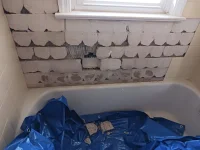To Demo or Not To Demo
I'm sorry to put this question into this forum,
but The Plasterers Forum seems to have a pulse.
(Unlike the Tile Forum I've joined)
Replacing square tiles with 15" x 30".
Tear out existing filler/glue/?, or leave it, fill around existing, and tiling over?
A tear out would allow a layer of insulation and cement board for stability.
Seeking opinions.
Thank you.
I'm sorry to put this question into this forum,
but The Plasterers Forum seems to have a pulse.
(Unlike the Tile Forum I've joined)
Replacing square tiles with 15" x 30".
Tear out existing filler/glue/?, or leave it, fill around existing, and tiling over?
A tear out would allow a layer of insulation and cement board for stability.
Seeking opinions.
Thank you.

